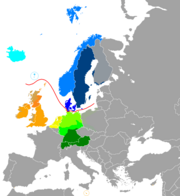Crimean Gothic leid
Crimean Gothic is ae extinct Aist Germanic leid that wis spak bi Crimean Goths in Crimea til the 18t yeirhunner.[1] It haes the Gothic leid as ae antecessor.
Attestation[eedit | eedit soorce]
Ae Crimean dialeck o ae Germanic leid is notit in a nummer o soorces fae the 9t yeirhunnner til the 18t yeirhunner. But ainly ane soorce shaws whit is kent anent the leid, that is a letter fae the Flemish ambassador Ogier Ghiselin de Busbecq, datit aroun 1562 an published fur the first time in 1589. This gies a leet o aroun achty wirds an a song in the leid.
Busbecq's accoont haes ae wee bit o problems. The informants wur nae unimpeachable; ane wis ae Greek spikker that haed Crimean Gothic as ae seicont leid, an the ither wis a Goth that wud maistly spik Greek insteid o Crimean Gothic. Forby, Busbecq's transcription wis maist likely influenced bi his ain leid, a Flemish dialeck o Dutch.[2] Forby, there are undoobtit typographical errors in kent extant versions o the accoont.
Maist vocabulary citit bi Busbecq is Germanic an wis recognised bi him.
| Crimean Gothic | Scots | English | Bible Gothic | Proto-Germanic | West Germanic | Old Norse | Dutch | German | Icelandic | Swadish |
|---|---|---|---|---|---|---|---|---|---|---|
| handa | haund | hand | handus (f.) | *handuz | *handu | hǫnd | hand | Hand | hönd | hand |
| schuuester | sister | sister | swistar (f.) | *swestēr | *swester | systir | zus(ter) | Schwester | systir | syster |
| hus | hoose | house | -hūs (n.) | *hūsą | *hūs | hús | huis | Haus | hús | hus |
| reghen | rain | rain | rign | *regną | *regn | regn | regen | Regen | regn | regn |
| singhen | singin | to sing | siggwan[1] | *singwaną | *singwan | syngva,
syngja |
zingen | singen | syngja | sjunga |
| geen | gangin | to go | gaggan[1] | *gāną | *gān | gá | gaan | gehen | ganga | gå |
de Busbecq cites wirds that he didna ken but the noo haev kent Germanic cognates:
| Crimean Gothic | Scots | Inglis | Bible Gothic | Proto-Germanic | West Germanic | Old Norse | Dutch | German | Icelandic | Norwegian | |
|---|---|---|---|---|---|---|---|---|---|---|---|
| meaning | cognate | ||||||||||
| ano | rooster | — (Auld Inglis hana;
compare hen) |
rooster | hana | *hanô | *hanō | haðnahani | haan | Hahn | hani | hane |
| malthata | said | mell | said | — | *maþlijaną | *maþlōn
*mahlōn |
mælti | — | (ver)mählen | mælti | mælte |
Busbecq alsae mentions ae definite article, that he records as bein tho or the. This form can mein ae gender distinction or allomorphy — the latter micht be ae akin til the English "the", that is pronounced /ðə/ or /ðiː/.
In 1780, Stanisław Bohusz Siestrzeńcewicz, ae Archbishop o Mogilev, visitit the soothart pairt o Crimea an Sevastopol. Accordin til his accoont, he met some Tatars that spoak a language seemlar til Nether-Saxon; this wis maist likely Crimean Gothic.[3]
References[eedit | eedit soorce]
- ↑ Todd B. Krause and Jonathan Slocum. "The Corpus of Crimean Gothic". University of Texas at Austin. Archived frae the original on 2 Mairch 2007. Retrieved 6 Februar 2008.
- ↑ Stearns, 1987, p.70
- ↑ Mithridates oder allgemeine Sprachenkunde; 1817, S. 168
Soorces[eedit | eedit soorce]
- MacDonald Stearns, Crimean Gothic. Analysis and Etymology of the Corpus, Saratoga 1978. Haes Latin tex o Busbecq's report an English translations.
Fremmit airtins[eedit | eedit soorce]
- Busbecq's accoont, in Latin
- Gothic Online bi Todd B. Krause an Jonathan Slocum, free online lessons at the Linguistics Research Center at the University of Texas at Austin, haes a lesson on Crimean Gothic
- Editions and Critical Studies, bibliography bi Christian T. Petersen

